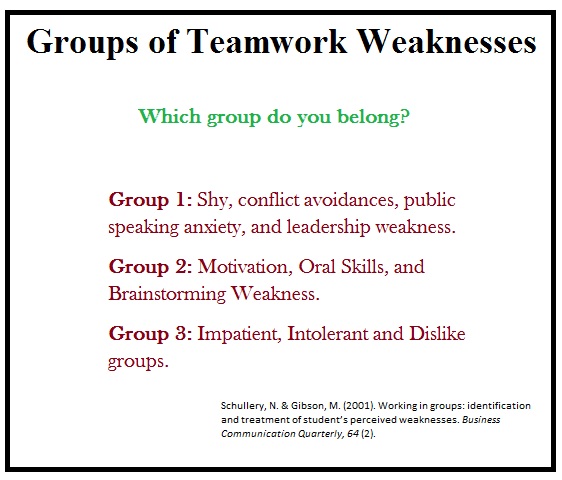Understanding the weaknesses employees have in their ability
to engage effectively in team-work is beneficial in creating higher levels of
organizational performance. As companies seek to develop new products and
service the use of teams become important in putting to effective use the
diversified skills. Certain weaknesses work in association with other
weaknesses and can be used as a starting point to improvement.
The use of work groups has become more common in modern
times as a concept borrowed from Japanese manufacturers. The ideal employee is often seen as that
person who is capable of working effectively in groups (Guffey, 2000). It is
through this group effort that individuals are capable of hedging their skills to
create stronger results through mutual synergy.
The skills needed to be a strong group player can be
elusive. Business leaders and employees alike can have difficulty understanding
these concepts and defining them precisely enough to be of significant use. According to Ainsworth (2000) strong group skills
include confidence in one’s abilities, interpersonal skills, open-mindedness,
listening skills, and an ability to recognize the contribution of others.
It is beneficial to see an example of the difficulties
someone may create if they have not developed these attributes. Let us assume
an employee named John is argumentative, seeks personal recognition above other
group members, refuses to listen to varying perspectives, is set in his ways,
and lacks personal confidence in his abilities. We might find John to be self-seeking
and unable to come to agreement with anything that doesn’t recognize the “rightness”
of his perceptions.
Such a group is likely to disintegrate on the single
influence of John and his personality. The more John is involved in the group
the more likely it will become ineffective wasting time, cost and resources.
John’s inability to develop proper teamwork skills will create an atmosphere where
either poor decisions are being made to appease John or group resistance begins
to form to thwart him. A single poor group member can impact the actions and
reactions of the entire group and the effectiveness of the company.
Business leaders and college professors can help improve
upon people’s weaknesses by helping them find strategies to recognize areas of
improvement and methods of overcoming these challenges. As students move into
the business world they will be more prepared through the relevant
instructional methods and self-awareness. Business and education can further
recognize these poor skills and provide relevant methods of overcoming them.
Due to this confusion of teamwork skills Schullery &
Gibson (2012), from Western Michigan University, have conducted research on
undergraduate business and organizational communication skills. The purpose of
the study can be summed in a single sentence, “How well does, or can, the business communication syllabus address
students’ group skill needs?” A total of 356 students participated in the
study through four 15-week semesters. Students were asked to rank their abilities
and skills throughout their courses.
The Results:
-Group of skill deficiencies seem to travel together in
factors:
.-Factor 1: Shy, conflict avoidances, public speaking
anxiety, and leadership seem to be associated.
-Factor 2: Motivation, Oral Skills,
and Brainstorming.
-Factor 3: Impatient, Intolerant
and dislike groups.
The study helps to come to some important understandings
that these skill deficiencies seem to travel together. For example, a person
who is shy is not necessarily unmotivated. A person who lacks oral skills is
not generally intolerant of others.
Importantly, many of the students were aware of their skill weaknesses
but have not developed abilities to overcome them. This inability leads to
continued poor group performance throughout a person’s life.
Let us move back to the example of John. His confrontational,
self-seeking, and rude behaviors is most likely to fall into Factor 3 which
means that these can be a result of poor skills such as impatient, intolerant
and dislike of groups. In these poor skills he will have an impact on the
nature and function of that group as he fails to compensate for his weaknesses.
It is through proper development and training that employees can both recognize
their weaknesses and learn how to overcome them.
Ainsworth, S. (2000). Teamwork 2000: multifunctional teams
help companies cut through bureaucracy and release creativity to improve their
bottom line. Chemical and Engineering, 77.
Guffey, M. (2000). Business communication: process and product.
(3rd Edition). New York: South-Western.
Schullery, N. & Gibson, M. (2001). Working in groups:
identification and treatment of student’s perceived weaknesses. Business Communication Quarterly, 64
(2).



